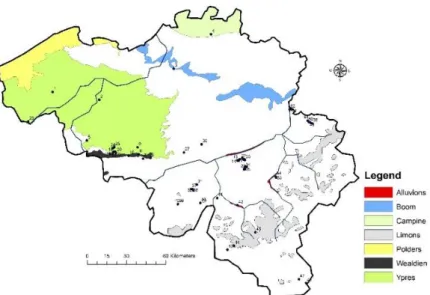6th International Geologica Belgica Meeting 2018
Geology Serving Society Leuven, 12-14 September 2018
Belgian clay geo-resources and their use for making compressed earth bricks
Lavie A. MANGO ITULAMYA1, Frédéric COLLIN2 & Nathalie FAGEL1
(1) AGEs - Argiles, Géochimie et Environnement sédimentaires, University of Liège, Belgium (2) Géotechnique, Département ARGENCO, University of Liège, Belgium
Abstract
This study has two objectives: contribute to the knowledge of Belgian clays and evaluate their use for manufacture of compressed earth block (CEBs). Nineteen Belgian clays formations were sampled in 56 sites and 135 samples were collected and analyzed. The analyzes focused on the determination of particle size, plasticity, nature and mineralogy, the main characteristics for assessing the suitability of the soil to make CEBs. These analyzes allow to classify the sampled formations in three categories: clays that can be used unchanged to make CEBs (2 formulations), clays that are suitable for the manufacture of CEBs but require modification (13 formulations) and clays that are unsuitable to the manufacture of CEBs (4 formulations).
1. Introduction
Raw earth designate the soil used in construction with less transformations. Due to its ecological, economic and physical properties, it faces a renewed interest. This is reflected in Belgium by the appearance of local producers of raw earth materials. The objective of this research is the valorization of Belgian clay deposits for the manufacture of raw earth bricks. Clays will be sampled, characterized and classified according to their ability for the manufacture of raw earth bricks, according to the technique of Compressed Earth Blocks (CEBs).
In several regions of Belgium, there are important clay formations, used for the manufacture of bricks, tiles, pottery, and also in the cement industry. The main clay deposits exploited in our country are Scheldt clays, Boom clays, Campine clays, Clays of Andenne and Condroz, Clays
of Entre Sambre-et-Meuse, Ypresian clays, Landen clays, Herve clays, Aachen clays, Ethe clays,
Wealdian clays, cover and alluvial silt and altered shale (Gulinck, 1958). These clays were the essential raw material used for this study.
2. Methodology
Field missions consisted in prospecting for clay deposits in 56 sites (Fig.1), and representative sampling. The sampling criterion was based on the variability of materials and the representativeness of facies. Exploration, outcrop description, mapping of the deposits were achieved using classical prospecting surveys (manual auger borings, sampling on the forehead). A total of 135 samples were taken. Laboratory analyzes covered the characterization of clay material sample during the prospecting campaign. The particle size of the samples was carried out by both sieving and wet laser granulometry. The plasticity or Atterberg limits was realized using the Casagrande dome. The nature of raw earth was determined by the combination of the values from the particle size, plasticity and methylene blue values. All these tests were done in the Geotechnology Laboratory and Argiles, Géochimie et Environnements sédimentaires Laboratory of University of Liège.
Figure 1: Location of sampled sites on the map of Belgian clay formations. 3. Results
The results allow to classify the studied raw clays in three categories (Table 1):
Categories Formations Description
A Campine clays: Turnhout Member); Paleoalterations clays of Famennian schists
Acceptable material, good particle size distribution and good consistency
B Scheldt clays; Campine clays: Rijkevorsel Member; Clays of Andenne and Condroz; Clays of Entre Sambre-et-Meuse; Boom Clays: Putte Member; Ypresian clays: Tielt Formation; Ypresian clays: Kortrijk Formation; Ypresian clays: Carnières Formation; Landen clays; Herve clays; Aachen clays; Wealdians clays; Ethe clays
Acceptable material but containing too much fine particles and requiring an addition of coarse particles (sand, gravel)
C Silt-Loam; Paleoalterations clays of Devonian schists and sandstone; Paleoalterations clays of Ordovician schists; Ardennes kaolin
Clays with low consistency and having too much fines
Table 1: Classification of raw clay formations. A: clays that can be used unchanged to make CEBs; B: clays that are suitable for the manufacture of CEBs but require modification; C: clays that are unsuitable to the manufacture of CEBs (C category).
4. Conclusion and perspective
Here 19 clay formations have been characterized on the basis of particle size, plasticity, nature and mineralogy in order to evaluate their use for manufacture of compressed earth blocks (CEBs). The raw clay formations were classified in 3 categories according to their convenience to make CEBs: 4 of them are not suitable for making CEBs, 13 are acceptable, but require modification, and 2 can be used without modification. Larger amounts (300 kg) of clay were collected at 5 sites. The next step will be the fabrication and characterization of Compressed Earth Bricks (CEBs) which will be characterized by the mechanical and hygrometric properties.
5. Reference
Gulinck M., 1958. Atlas de Belgique. Planche 39. Carrières. Bruxelles : Académie royale de Belgique, Comité national de Géographie, Commission de l'Atlas national.
